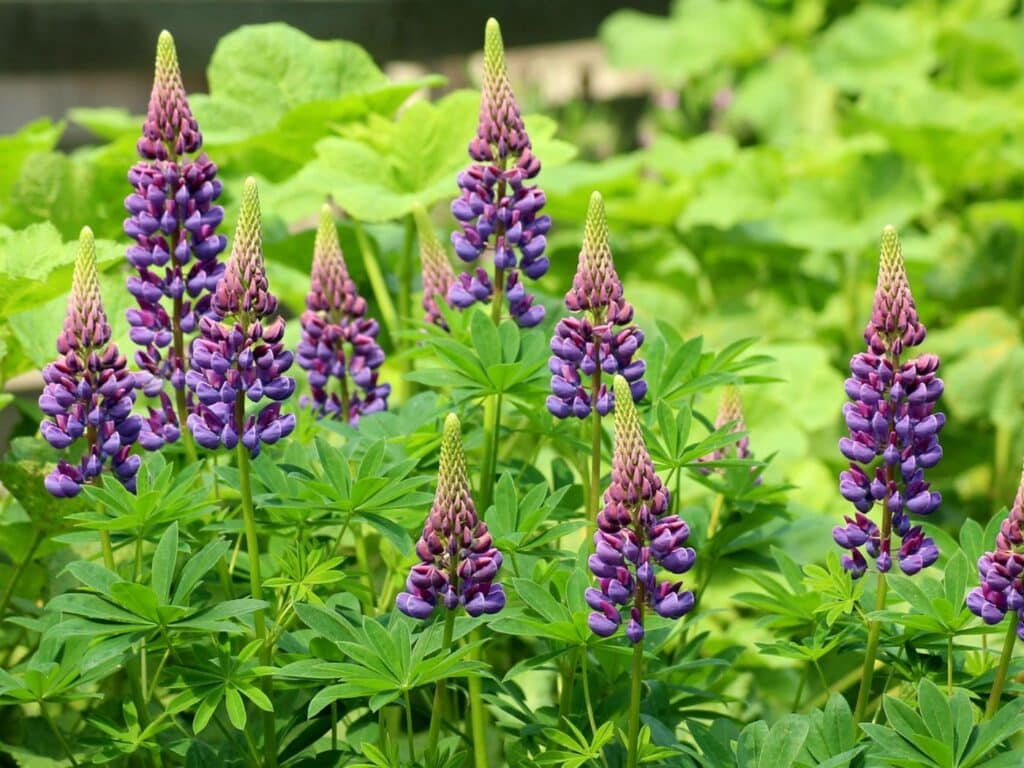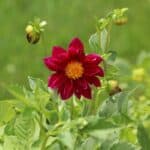Lupines (Lupinus) or bluebonnets are the perfect flowering plants to grow in your garden if you want to add lots of color and texture to your spaces. These perennials or annuals produce clusters of flowers on tall rocket-shaped spikes and come in vivid colors like white, pink, purple, yellow, or red.
Lupine is very useful for attracting pollinators to your garden, and it is often grown for its extraordinary ability to restore the nitrogen levels in the soil.
The vivid flowers look lovely if combined with lupine companion plants like juniper’s beard, yarrow, tickseed, sedum, or asters.
Lupine is also often used in vegetable gardens because it can restore the soil so future crops can flourish.
In this guide, we will learn more about these companion species and discuss creative ways to use these beautiful plants in flower gardens.
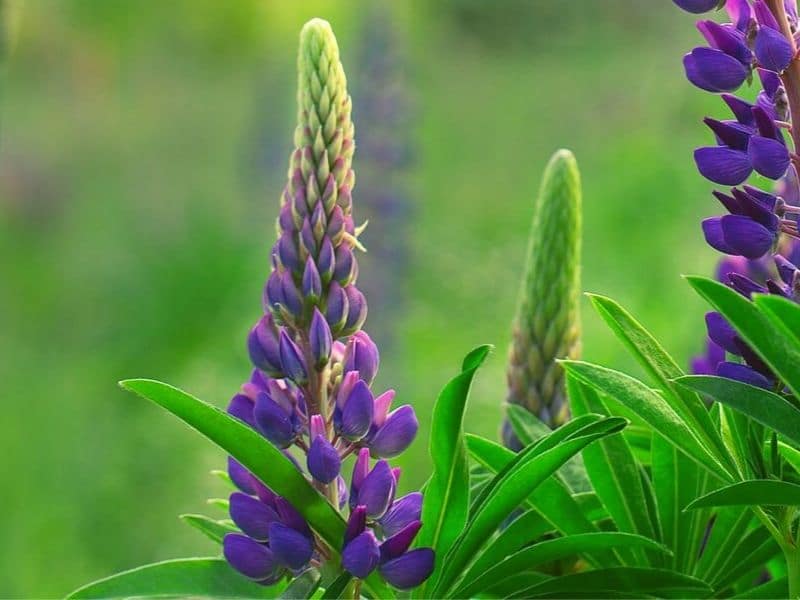
What to Grow with Lupine
Lupine will only flower appropriately if it is grown in full sun. In warmer regions, it can be grown where it will receive a little afternoon shade. This plant also requires fertile soil that is slightly acidic and should be placed in well-drained soil. These flowers prefer dryer conditions and should only be watered during dry spells when the soil has dried off completely.
If you want these flowers to grow strong and bloom vigorously, pair them with companion species that also love direct sunlight and dry soil conditions.
Here is a quick look at some of the best neighboring plants to grow alongside Lupine.
Juniper’s Beard
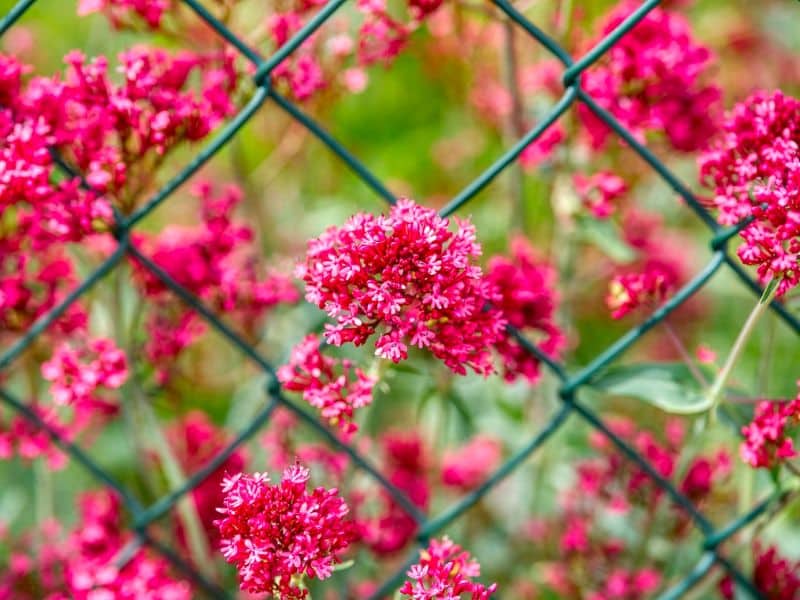
Juniper’s beard (Centranthus ruber) or red valerian is a terrific companion species to grow with Lupine in cottage gardens. This hardy perennial is popular because it blooms nonstop from late spring to late autumn.
This flowering plant prefers warm weather and will flourish in a full-sun position. The plant cannot tolerate humidity and should be grown in well-drained soil. It is also drought-tolerant and should be watered moderately.
Red valerians will only grow up to 36 inches tall, while Lupine can grow up to three feet tall. Its shorter height makes it an ideal ground cover in front of the Lupine to keep the soil cool on hot days.
Tickseed
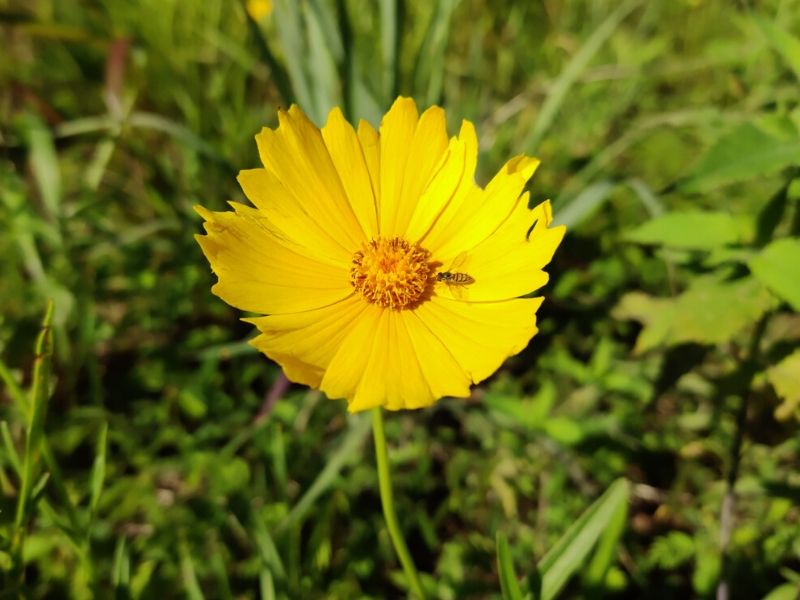
Tickseed (Coreopsis) will add texture and contrast to your garden because it has delicate textured leaves and vivid yellow flowers.
These vivid flowers should be planted in full sun, or they can become lanky. In warm regions, they will appreciate some afternoon shade. These flowers can tolerate well-drained soil and should be deeply watered regularly whenever the earth is dry.
Tickseed can grow quite tall, with some varieties reaching up to 9 feet tall. Because of their size, it is best to plant these tall flowers toward the back of your garden with Lupine in the front to conceal the plain base of the taller plants.
Yarrow

Yarrow (Achillea millefolium) or devil’s nettle will add lots of color to your garden bed because it comes in many colors, like white, soft pastel tones, bright yellow, red, orange, and gold.
These lupine companions will flourish well if you plant them in warm and dry areas in your garden. The water-efficient plants thrive in full sun and can tolerate any well-drained soil. They are drought-tolerant and shouldn’t be watered too often.
Yarrow and Lupine can have similar heights, so you can easily mix these perennials among perennial lupine varieties to create showy mixed garden beds.
Related: Yarrow Companion Plants
Aster
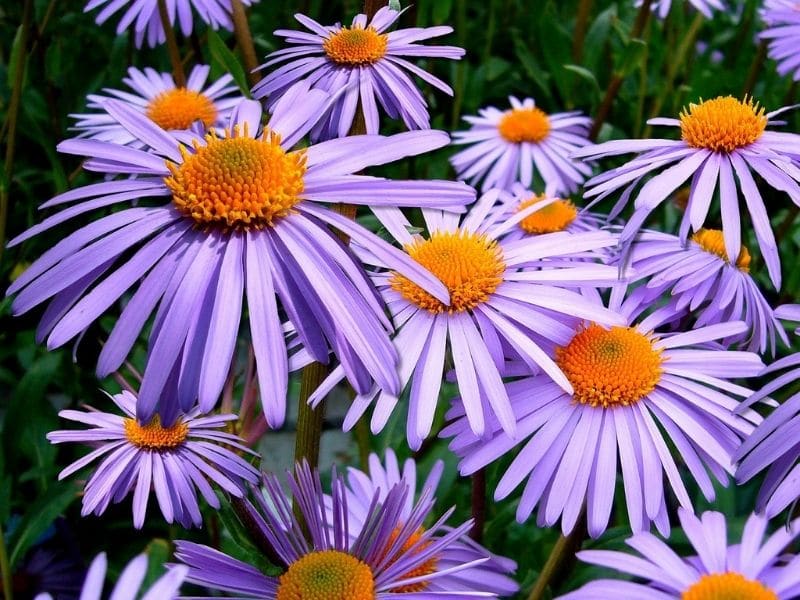
Asters (Aster) or Michaelmas daisies will cheer up your garden spaces with their vigorous purple blooms. There are 160 varieties of aster, which can range from 1 up to 6 feet tall.
Asters need plenty of direct sun to flower correctly, but some varieties can tolerate a little shade. These bright flowers should be planted in free-draining soil, and they should be watered sparingly, or they can start developing root rot.
When doing companion planting with asters and Lupine, you should be careful to place shorter aster varieties in the front and taller varieties behind Lupine. For a purple color palette, you can combine purple or pink Lupine or pair these purple flowers with yellow Lupine to create more contrast.
Sedum
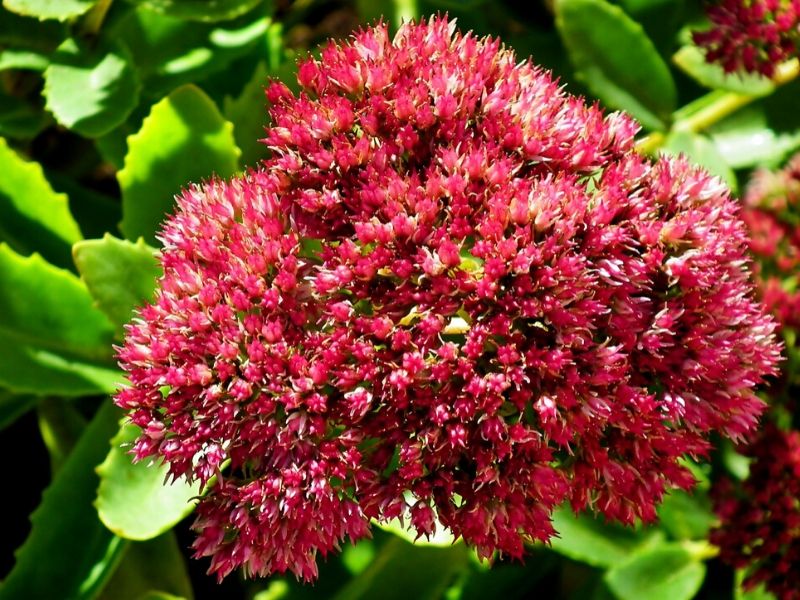
Sedum flowers (Sedum), also known as stonecrop or roseroot, is a terrific flowering plant for dryer garden spaces. These succulents will add color to your garden with vivid foliage and bright flower clusters.
If you want them to produce many flowers, you should plant them in full sun. They can also tolerate partial shade but should be grown in poor sandy soil types that drain properly, or they can develop fungal diseases.
A row of sedums will look charming in front of taller lupine flowers, but you can also add trailing sedum varieties to your garden if you need a good ground cover for your garden beds.
What NOT to Grow with Lupine
Because Lupine is sun dependent, it is usually best not to grow it with shade-loving varieties like ferns, begonias, or coral bells. These plants can survive in light shade positions but will die out if they don’t get any direct sun.
Lupine is also drought-tolerant and should only be watered when the soil is completely dry. Because of its hardy nature, it is best to avoid combining it with moisture-loving plant species like hydrangeas or creeping jenny.
Landscaping Ideas for Lupine and Companions
Lupine can look striking if you combine it with the companions we discussed in this guide and it can be used to create all sorts of showy spaces like the following.
Cottage Garden Spaces
Lupine and most of the companions we discussed here are excellent for showy cottage garden spaces. You can grow flowers like lupine, sedum, asters, and tickseed in front of white-picked fences or rocky walls to create texture-rich gardens full of life and color.
Showy Rocky Gardens
If you have sandy and rocky soil with lots of large rock boulders and other natural elements like decorative wood stumps then you can mix and match lupine and showy companions like juniper bears or aster in random spots in your garden. The combination of tall florals will add lots of vertical interest and can fill out blank spaces among rocky garden features.
Cutting Gardens
All the flowers in our list are superb for cut flower gardens and will complement one another. Mix these flowers or grow them in rows to harvest and create showy bouquets or indoor flower arrangements.
Final Thoughts
Lupine can look striking if you grow it next to other flowering companion plants like asters, yarrow, sedum, juniper’s beard, or tickseed. These flower combinations are ideal for cottage gardens, cutting gardens, and enhancing the aesthetics of rocky garden scapes.
Our guide made it easier for you to find suitable companion plants for your garden to create beautiful spaces that are easy to care for and water efficient.
Learn more about Lupine symbolism to see why people love this plant!

